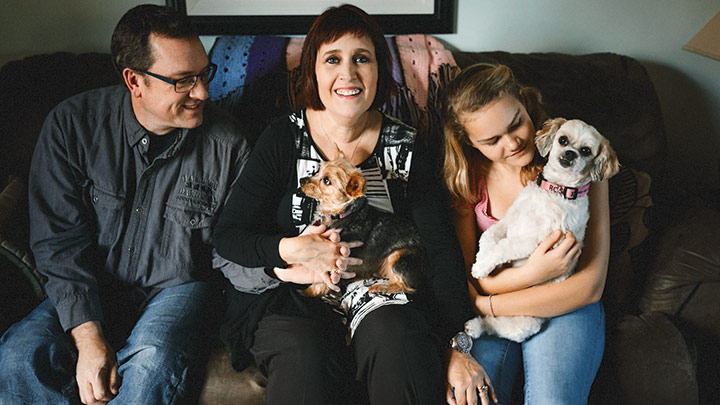
February 28, 2017

Shelley Castor, middle, with her husband and daughter, received life-saving emergency stroke care in less than 30 minutes from Alberta’s Stroke Program.
Story by Debby Waldman | Photograph by Paper Deer Photography
Red Deer mom Shelley Castor was having a stressful day. The family cars were in the repair shop, she had errands to run and the ATM in the bank lobby didn’t work.
She had just reached the teller when “something ticked on the right side of my brain and I felt light-headed,” she recalls.
She looked down. Her left hand was curving even though she wasn’t moving it. She felt her left cheek droop. Her voice didn’t sound right. Castor, 49, recognized what was happening.
“I am having a stroke,” she told the teller. “You need to call my husband.”
Castor gave her the number and stood aside while the teller called.
She expected the woman would also call an ambulance, but instead the teller motioned the next customer to come forward.
The teller didn’t know that every minute is critical when someone is having a stroke.
The Alberta Stroke Program’s Quality Improvement & Clinical Research (QuICR) project has been making stroke care faster, more efficient and more effective since 2015. QuICR is a partnership between the two Alberta medical universities and the Cardiovascular Health and Stroke Strategic Clinical Network at Alberta Health Services. It has turned Alberta into a world leader in stroke treatment.
About 85 percent of strokes are ischemic; they’re caused by a clot that blocks blood flow to the brain. Dr. Michael Hill, a Calgary neurologist and the Alberta Innovates (previously Alberta Innovates – Health Solutions), researcher leading the project likens an ischemic stroke to a plumbing problem.
The clogged pipe is a blocked artery, and the drain cleaner is a drug called Alteplase. Given through an intravenous line, Alteplase essentially melts clots; it’s only effective when delivered quickly.
Research shows that for every minute that a major artery is blocked, approximately two million neurons die. In a matter of minutes a person can lose tens of millions of neurons, making stroke the number one cause of disability in Canada.
When Alteplase was approved in the late 1990s, the international standard for giving a patient the drug after entering the hospital, known as “door-to-needle,” was 60 minutes. During that time, patients must also have a CT scan to determine if their stroke is ischemic or hemorrhagic. Hemorrhagic strokes, which account for 15 per cent of cases and involve bleeding in the brain, can’t be treated with Alteplase.
In 2012, neurologists at a stroke centre in Helsinki published a paper announcing they had cut the door-to-needle time to 20 minutes. Hill, the director of the Stroke Unit for the AHS’ Calgary Stroke Program, took their paper as a challenge. He wanted a median time of 30 minutes in Alberta.
To reach this goal, the QuICR team involved engineer Noreen Kamal, PhD, to lead the process, and worked with 17 stroke centres and hundreds of healthcare professionals. To streamline care, hospitals without a staff neurologist can now contact one immediately through a telehealth system, and EMS workers alert hospitals of their arrival so health professionals can “swarm” the patient, obtain a history and begin treatment.
Alberta now has an average door-to-needle time of 35 minutes. Alberta is delivering quality stroke care with rapid speed. “It gives me goosebumps,” says Kamal, who also manages the QuICR program.
Castor credits the project with saving her life. By the time her husband got her to the hospital, her left side was paralyzed. But because her door-to-needle time was 23 minutes, she began regaining movement and speech within 24 hours.
Six months after the stroke, she tires more easily than she used to, words don’t come quite as quickly, and her left hand is always cold. But she is back home with her husband, daughter and two dogs, and for that she is grateful.
“This drug is amazing, but you have to get to the hospital on time. I’m very lucky to be here,” she says.
“Time is brain” is a common phrase among stroke care providers, and the acronym FAST can help you remember three key signs of a stroke: F is for face, which may droop during a stroke, making it impossible to smile. A is for arms, both of which may be hard to lift during a stroke, or one of which may keep drifting down. S is for speech, which is often difficult to either muster or understand during a stroke. T is for the all-important time it takes to get care. If you or someone you know is having a stroke, call 911 immediately.